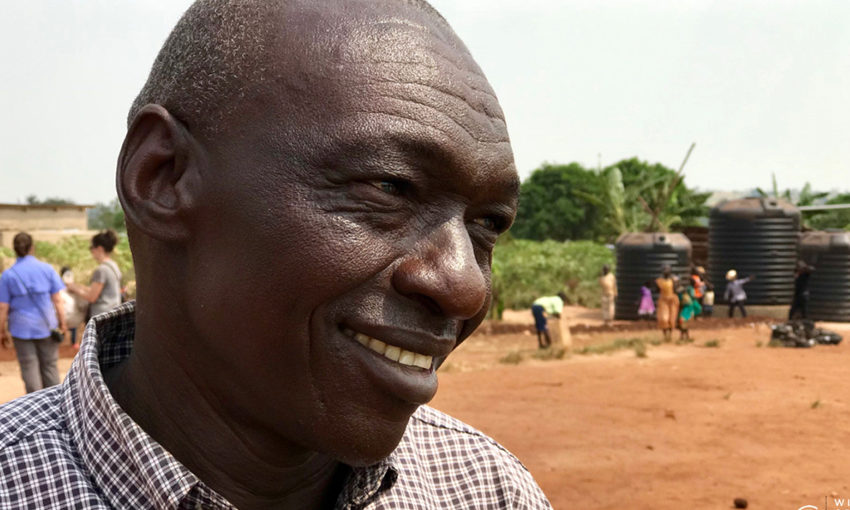

If you’ve followed Open Eyes for any length of time, Kiryandongo Refugee Camp is probably familiar to you. One of our Mobile Messengers, Sosthen, pastors a church in the camp. We’ve also sent teams of women, medical professionals, and students to help with a variety of physical, emotional and spiritual needs.
But the history of Kiryandongo is one of long-term assistance for refugees. The camp was first used in 1954 when British nationals helped Kenyan refugees fleeing the Mau Mau uprising resettle. After a time, it became uninhabited until the Ugandan government dedicated the land as an official refugee camp in 1990 and since then has hosted men, women, and children from Rwanda, Kenya and the Democratic Republic of Congo. It’s most significant population surge was in 2014 when the civil war in South Sudan forced people to find sanctuary from the conflict. The population of the camp is now estimated between 50,000 and 60,000 refugees.
Meeting the People of the Kiryandongo Refugee Camp
The men and women who comprise this camp have known the horrific consequences of violence, war, and poverty. Many have endured the traumatic loss of loved ones or don’t know where their family members are. Unsettled and unsure in a new country, the hurdles these people face are many.
Here are just a few of the needs facing the refugee camp:
- Limited access to clean water. Where there is water, lines are often long.
- Little to no access to medical help. While there are three medical stations in the camp, they are often under-staffed and have limited knowledge and equipment to help those in need. This leaves the elderly, pregnant women and children in a vulnerable state.
- Poor food rations due to cuts in August of 2016, leading to refugees sharing food and skipping meals.
There is hope, however. Aid is finding its way into pockets of the camp.
- More than half of people living in the camp with identified special needs are receiving the aid and care they need.
- UNESCO is sending in teams to help establish opportunities for education for children in the camp.
- Increased aid to help refugees and Ugandans learn how to live and work together to try and reduce violence in the camp.
The needs of the camp are many and varied. The enormity of poverty and privation can seem overwhelming. Yet, God is at work in the midst of extreme hardship and heartbreak.
Meet Pastor Sosthen
Walking through the dirt paths among his peers there is something unique about the man. It’s not his sturdy, lean build as a leader in the Moru tribe. It’s not the look of a weathered face that has forgotten the number of deaths and broken hearts he’s witnessed or the reality that corruption and war have destroyed the freedom for which he fought. What makes this man stand unique his the smile stretching his across his face, it’s vibrant and a mile-wide.
It’s not a fake smile nor is it an easy smile. In 2016, Sosthen fled South Sudan with his family because of the civil war. He settled his family in the Kiryandongo refugee camp knowing the life of a refugee was one of turmoil. They knew refugees lacked food, education, water, jobs, and a home, but for Sothen, his wife, Veronica, and their 12 children the life of a refugee was better than the future they faced in South Sudan.
Sosthen and Veronica began building a mud hut home for their family. After becoming foster/adoptive parents to dozens of children whose parents died due to war, disease or suicide, they had to build another home. He then built their church. The mud and stick building became a symbol of hope in the camp. Then, he built a school providing education for children who had been forgotten. Then, he planted a garden to employ and feed the community. Then, he added water barrels for drinking water.
This year, 600 kids attended the school Sosthen built. Dozens of kids received vaccination from diseases. A dozen orphaned children found a home in Sosthen and Veronica’s mud hut. The community ate and drank without fear of starvation. Sosthen and Veronica gathered over 800 women from 44 of the 45 tribes fighting each other in South Sudan for monthly worship services in the camp. All the while, they suffered the death of a son, threats from the community, and the knowledge that a flood or drought could change everything.
Walking through the camp, there is a man and his wife, who stand through victory and defeat, heartache and joy and blessing and suffering with smiles on their faces that reflect the size of the God living in their hearts.
If the story of the Kiryandongo refugee camp has inspired you, we invite you to check out our Legacy Giving Club. The Legacy Giving Club was established to help men, women, and children like those in the Kiryandongo camp with physical, emotional and spiritual resources. Your support through giving and prayer makes continuing the work of Mobile Messengers and Open Eyes possible. You can learn more at withopeneyes.net/gift.
Sources:
UNHCR
UNHCR – Uganda Refugee Portal
UNESCO
Real Medicine Foundation

